July 19, 2021
Kernavė Mounds - UNESCO Archeological Site of Ancient Lithuania Capital
Culture, Geopolitics, Guide, History
Top attractions:
Medieval Capital of Grand Duchy of Lithuania
As the oldest known Capital of Grand Duchy of Lithuania, Kernavė is often falsely claimed as the cradle of the state. In fact, it was the Capital of Duke Traidenis, who probably have ruled it even during the reign of King Mindaugas, whose Capital still remains a mystery to this day. Some historians have falsely named Kernavė as his Capital as well, but there is no scientific proof of that. Assuming that Mindaugas was a or the Duke of Lithuania in a smaller sense (original area of Lithuanians before they united other Baltic tribes and duchies under one banner), his original seat must have been somewhere to the east of Kernavė, where were the actual original lands of Lithuania (the area of current east Lithuania including Vilnius, but mostly current Belarussian and Russian lands). Meanwhile, Kernavė was a part of either Deltuva or Neris – the historical regions of Aukštaitija (ger Owsteiten).

I imagine the mounds of Kernavė were carved out of the slope, visible behind and around the hill forts. Photo by Alis Monte [CC BY-SA 4.0], via Connecting the Dots
Despite the historical technicalities, this ancient archeological site is absolutely remarkable. The Old Kernavė complex consisted of five mounds in total with the town built nearby in Pajauta Valley, closer to River Neris. The whole landscape with carved mounds is clearly visible to this day. It is reminiscent of the greatness of the ancient Capital, which has left such obvious marks even 600 years after it was burned down during the Lithuanian Civil War (1389-1392). This once more has shifted the ever-changing history of Kernavė. One of the most intriguing facts about this settlement is that archeologists have found remains of an III-IV century town, which had to relocate its population to hill forts and the upper part of the town (the current location of Kernavė) once the Teutonic Order arrived into the region. I bet most of the intriguing information about this ancient settlement is probably lost to the history.
Kernavė remained the Capital of Grand Ducky of Lithuania until the reign of famous Grand Duke Gediminas, who first moved the Capital to Trakai and soon after to Vilnius – the current Capital of the Republic of Lithuania.
Ducal Seat of Traidenis
Before Kernavė was the Capital of Grand Duchy of Lithuania it was the ducal seat of Traidenis, who together with the city rose to the top of chain command of the rising state. He is often regarded as the second most prominent ruler of Lithuania in the XIII century, falling just after King Mindaugas. Despite that, I doubt that Kernavė got its shape during his reign.
There is archeological evidence that this area was inhabited by humans since the Paleolithic era. Though it is hard to believe that Kernavė got its geo-shape in the Stone Age, it was most likely have been formed with time, until it first came into the pages of history in 1279 as the Capital of Grand Duke Traidenis, which was besieged by the Livonian branch of the Teutonic Knights. Unlike King Mindaugas, Grand Duke Traidenis didn‘t fancy getting baptized. Naturally, this didn‘t help to maintain friendly relationships with the Order. During his reign, the armies of Grand Duke Traidenis have killed three masters of the Livonian Order. The last one was chased up to the current day Latvia after the siege of Kernavė, mentioned before, and has perished in the battle of Aizkraukle.

You can easily spend a couple of hours walking around Kernavė Archeological Site. Photo by Alis Monte [CC BY-SA 4.0], via Connecting the Dots
It feels to me that Grand Duke Traidenis with his Capital at Kernavė is often left out very underrated by the locals in the shadow of the Baptized rulers of the Grand Duchy of Lithuania like King Mindaugas and Grand Duke Vytautas. Having been surrounded by enemies from all sides, not only Grand Duke Traidenis managed to expand the territories of the state, but remained a Pagan ruler until his natural death in ~1282, Kernavė. That is badass.
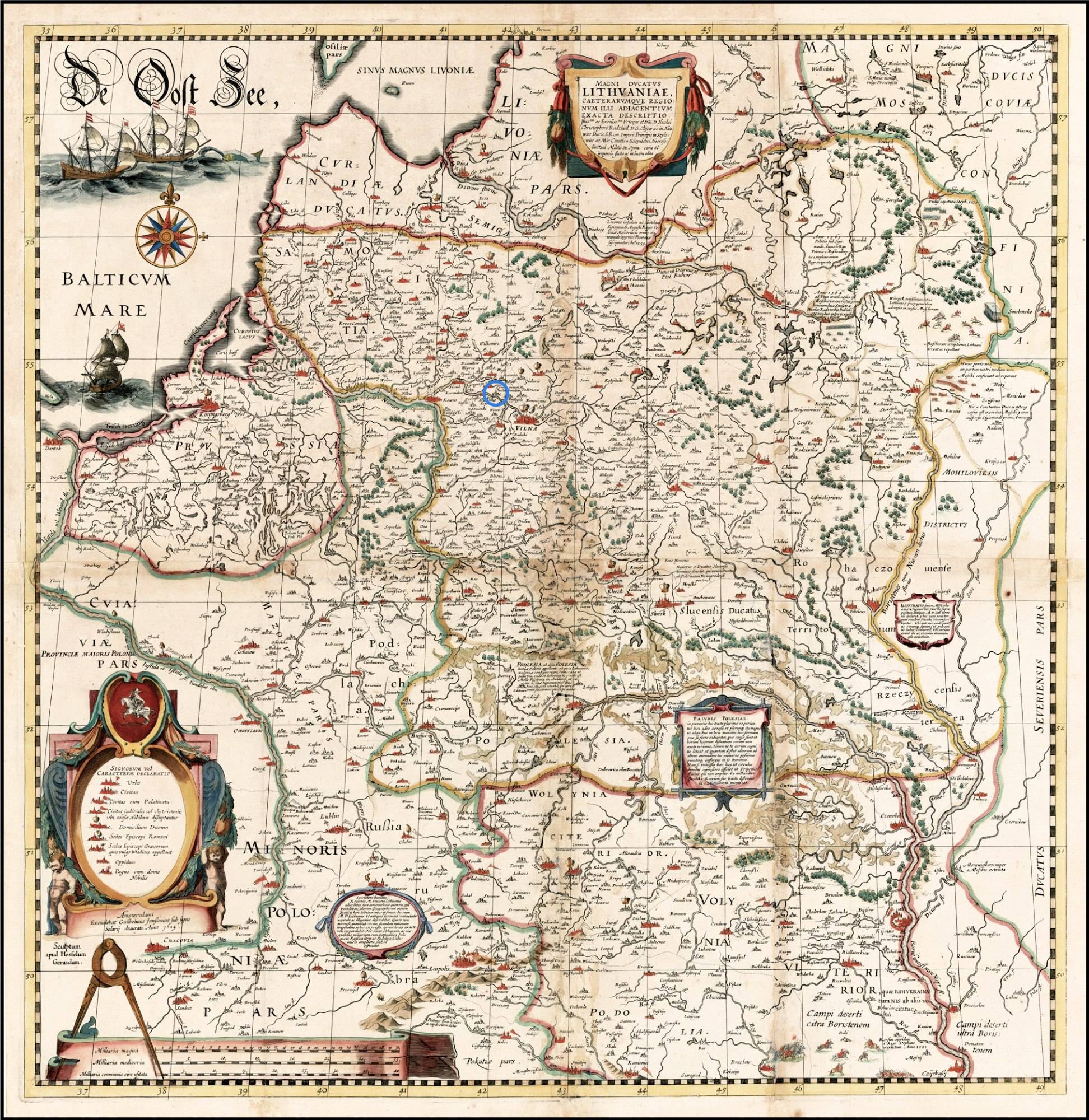
Kernavė on famous Grand Duchy of Lithuania map – Magni Ducatus Lithuaniae.
Kernavė Details
- Location: Širvintos district
- Ethnographic region: Aukštaitija (ger Owsteiten)
- Coordinates: 54.8867° N, 24.8545° E
- Distance from Vilnius: 38.2 km / 23.7 mi
- First mentioned: 1279 CE (Teutonic Order)
- Population: 272 (2011)
- Area: 2 km² / 0.77 mi²
- Forecast: Kernavė weather
- Best time to visit: Late spring, summer & early autumn
- Accommodation: Kernavė & Vilnius
Map of Kernavė

The old settlement was located in Pajauta Valley between River Neris and Kernavė Mounds. Photo by Alis Monte [CC BY-SA 4.0], via Connecting the Dots
10 Best Places to See in Kernavė
Though most of the visitors come to Kernavė to see its UNESCO Archeological Site of the old pagan capital of Grand Duchy of Lithuania, there is much more to see in the area. Your trip to the town could be easily extended from a couple of hours trip to a full day trip. Below is the list of places I found interesting and unique to Kernavė. You can also find them on the map.
1. Kernavė Mounds
The whole complex of the ancient settlement consists of 5 different mounds: Altar Mountain, Lizdeika mound, castle hillfort, Krikeikiškio mound, and King Mindaugas hillfort although there is no proof that Kernavė was his capital. The oldest of them is Altar Mountain, dating about a thousand years BC. Without a doubt, Kernavė Mounds is the place to visit in this ancient Lithuanian town.
2. Pajauta Valley
Among many legends surrounding Kernavė pagan site, people say that Kriwe-Kriwajto Lizdeika (In Baltic tradition, Kriwes were the Priests of Pagan religion. They were an equivalent of Celtic Druids or Zoroastrian Magi) used to live in Kernavė, and even after the Christianization of Grand Duchy of Lithuania in 1387, he continued to protect the sacred fire on the altar mountain together with priestesses. The most beautiful of the was Pajauta, hence the name of the Pajauta Valley.
3. Kernavė Old Settlement Reconstruction
Having visited Kernavė UNESCO Archeological Site quite a few times, it is always a pleasure to find something new. The reconstruction of old settlements is the newest addition to the whole complex of Kernavė Mounds.
Though the original site of the old settlement was in Pajauta Valley, this reconstruction is located on a hill to the west of Kernavė Mounds.

Kernavė Old Settlement Reconstruction. Photo by Alis Monte [CC BY-SA 4.0], via Connecting the Dots
4. Kernavė Archeological Site Museum
If you want to dive a bit deeper into the past than the landscape of Kernave can bring you – Kernavė Archeological Museum is the place to go. You‘ll be surprised by the collection of more than 20.000 objects, but remember that the archeological history of Kernavė goes as far as it possibly could go – to the very dawn of post-glacier pre-historic times.
5. Iron Wolf Statue
The first version of the statue was built even before the World Wars but later was destroyed and the Iron Wolf had to be rebuilt. Contextually, Kernavė might be not the best place for such a statue but it is worth visiting nevertheless. Iron Wolf is a mythical creature from Grand Duke Gediminas’s dream, which inspired the foundation of the current Capital of Lithuania – Vilnius. In other words – Iron Wolf to Vilnius is the same as She-Wolf to Rome.
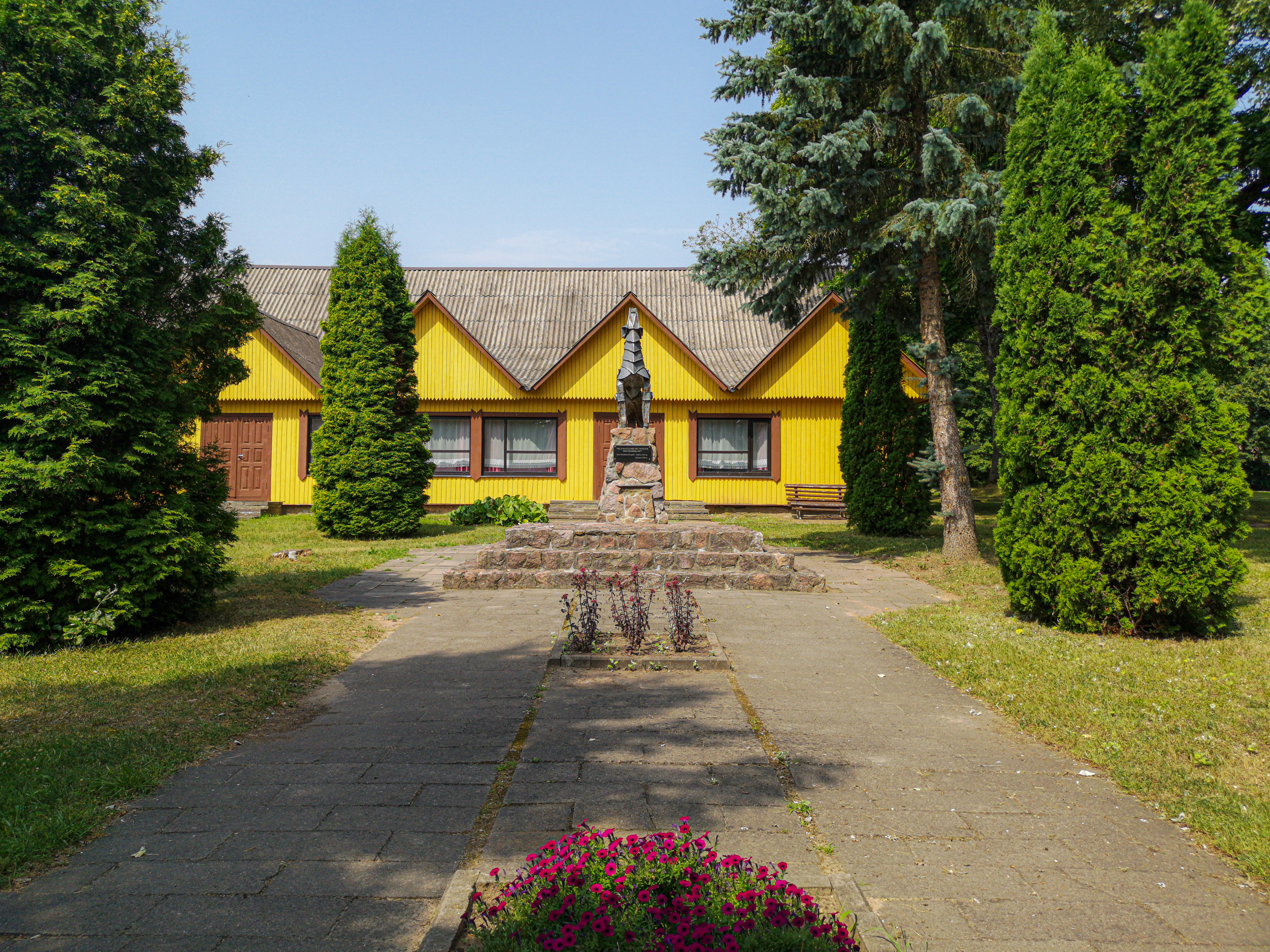
Iron Wolf Statue, Kernavė. Photo by Alis Monte [CC BY-SA 4.0], via Connecting the Dots
6. Christian Sites
Being the center of the Pagan Grand Duchy of Lithuania, Kernavė finds itself full of various interesting Christian sites like Moses statue, 100-year-old Church of Holy Lady, old wooden chapel, and the remains of the old church, presumably built on the top of the old temple of Perkūnas (Zeus of the Lithuanian Pagans) by the Grand Duke Vytautas himself.
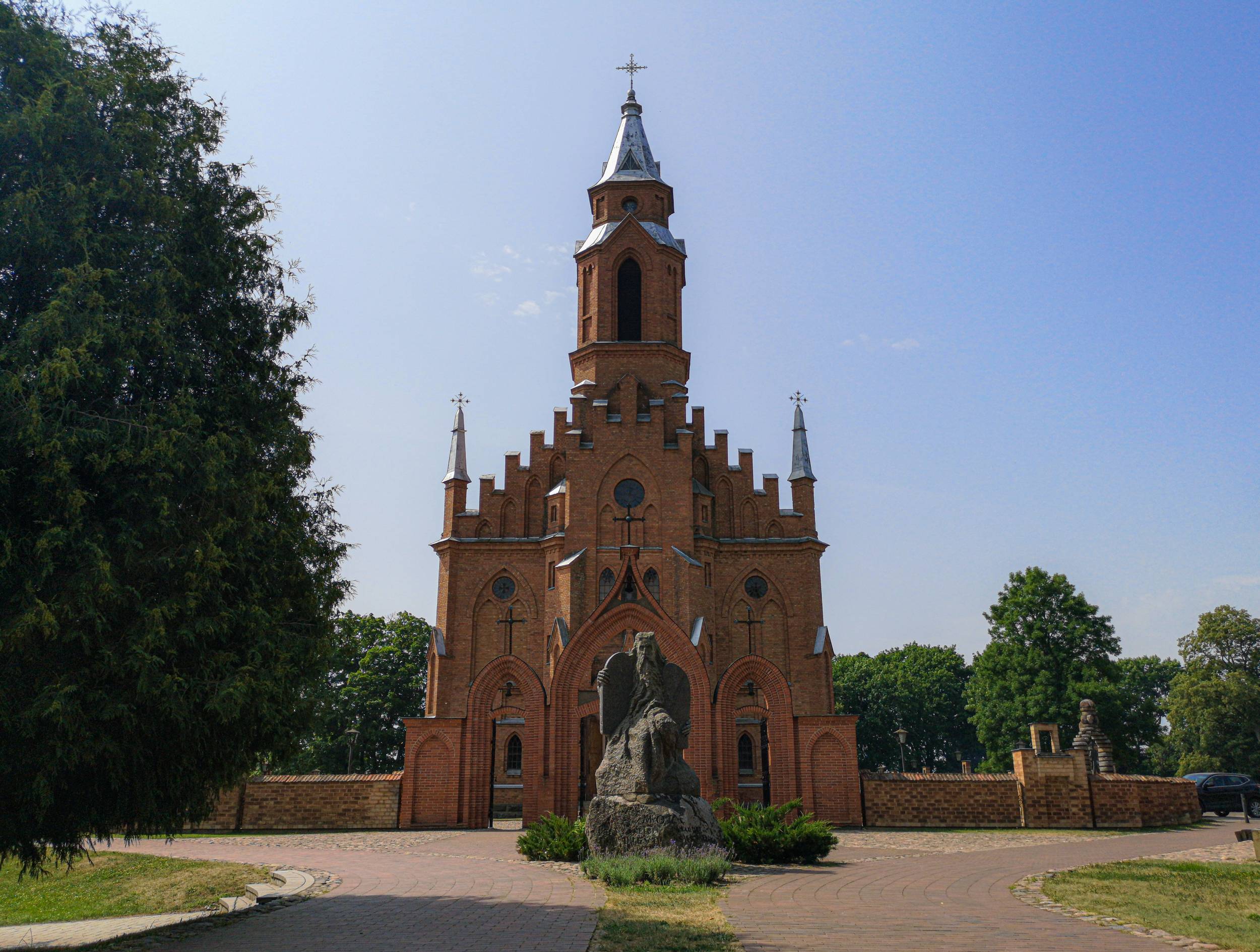
Moses Statue and Kernavė Holy Lady Maria Church. Photo by Alis Monte [CC BY-SA 4.0], via Connecting the Dots
Such density of Christian places is not surprising. To appeal to the new believers, Christianity, like any other religion, tried to disguise itself as a continuation of the old traditions. Though it expanded into the Baltics as a killing parasite, Christianity played a vital role in the fights for independence in the Late XIX and Early XX centuries.
7. White Mountain
Though not entirely a mountain, or even a hill, White Mountain provides a mesmerizing panorama of River Neris and the surrounding forest. This is a great viewpoint to experience the typical landscape of Lithuania.
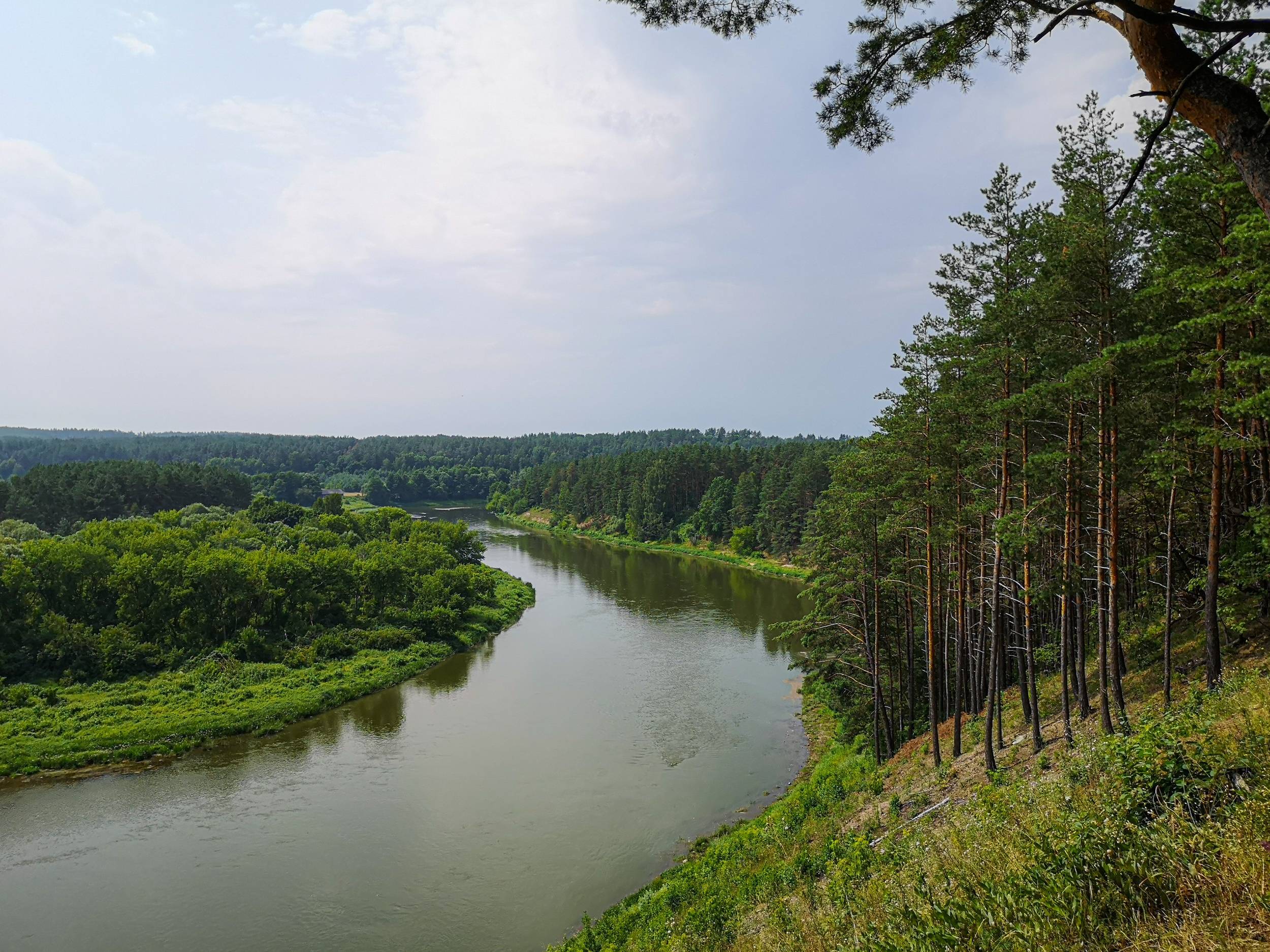
View from White Mountain, Kernavė. Photo by Alis Monte [CC BY-SA 4.0], via Connecting the Dots
8. Kernavė Educational Hiking Route
If you want to experience something else than the history and archeology of Kernavė for a change, this educational hiking route is the place to go. Built solely for recreational purposes, the 3 km / 1.86 mi trail will uncover the local beauty of nature, which Pagan Lithuanians used to cherish so much.

Kernavė Educational Hiking Route leads through a beautiful forest. Photo by Alis Monte [CC BY-SA 4.0], via Connecting the Dots
9. Kernaveland
What public capital can’t do, the private sector can. Kernaveland is a tavern and accommodation, opened by a chef from France. It is built on top of a Soviet collective farm, turning this brutalist monstrosity into a Medieval Castle. Words simply can’t describe it, you better see it yourself.
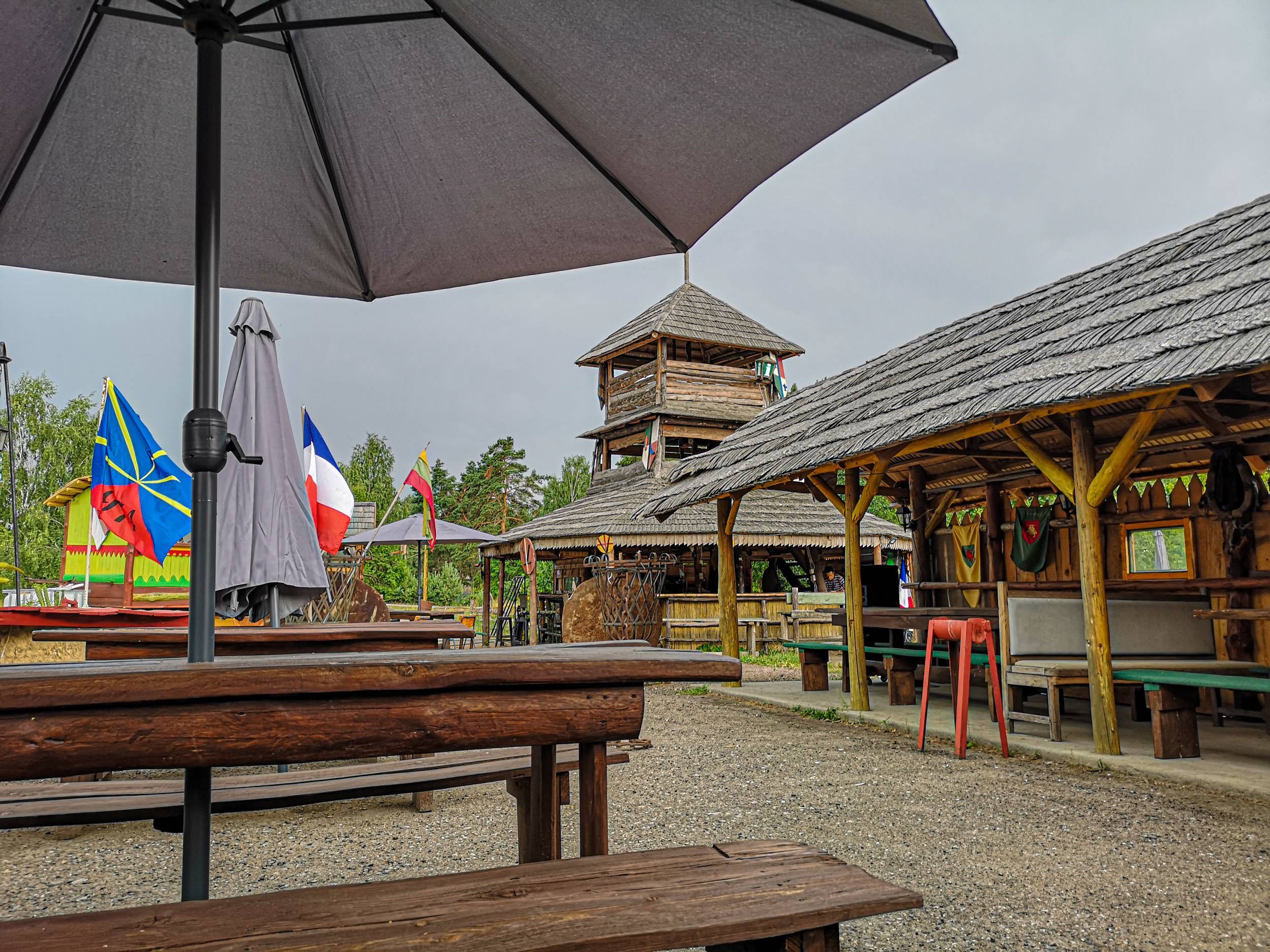
Kernaveland is one of the most bizarre things I’ve seen in Lithuania (in a good way). Photo by Alis Monte [CC BY-SA 4.0], via Connecting the Dots
10. River Neris
None of it would be possible if it was not for River Neris. Today, it is the second-longest in Lithuania, but back then Neris might have been the most important river in the newly formed state. Before King Mindaugas united the lands into the Grand Duchy of Lithuania, there was a separate Duchy under the same as the river. It is very possible that Kernavė might have been the Capital of Neris before it became the capital of the state under the rule of Grand Duke Traidenis.
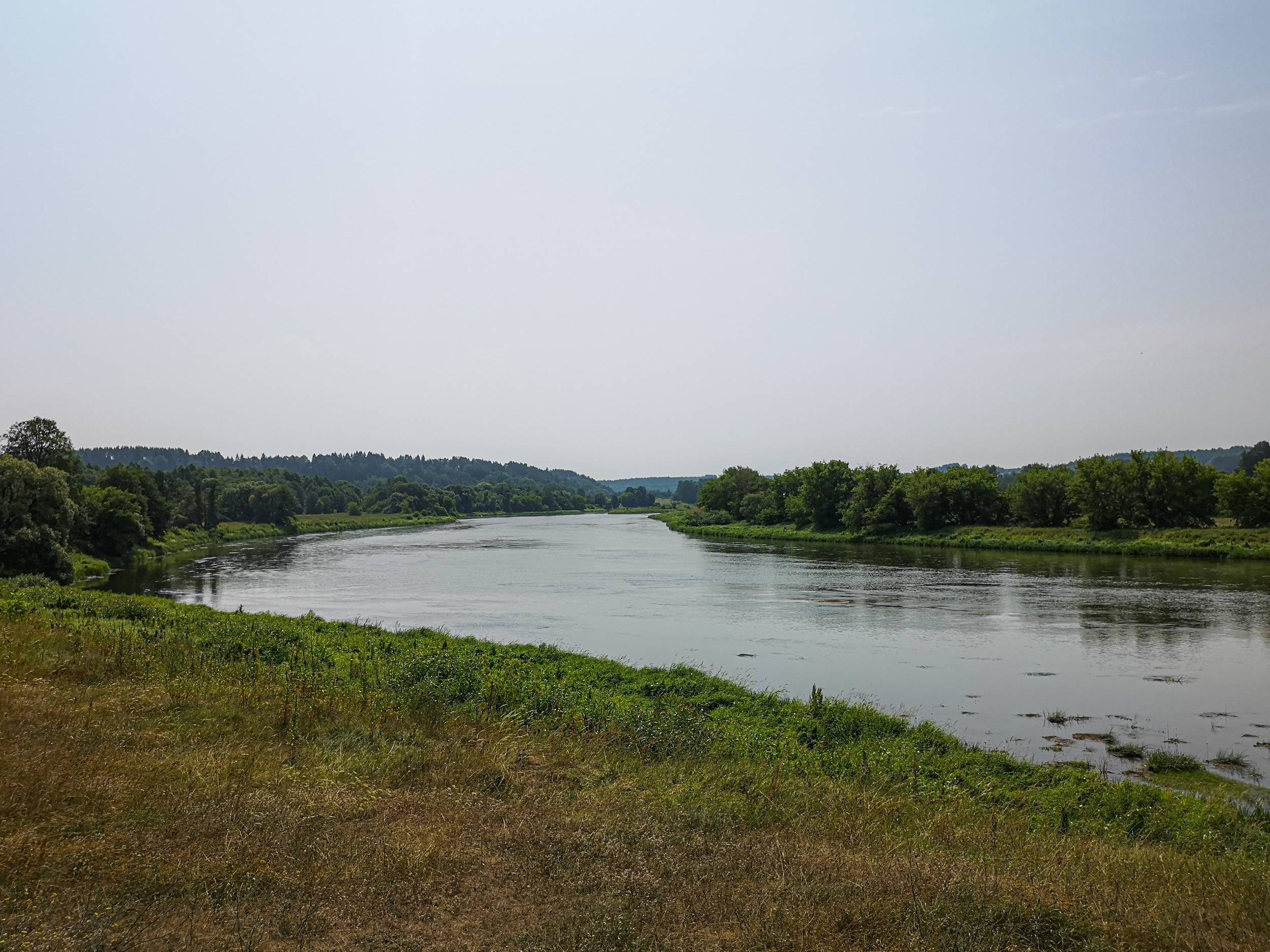
Neris is the second longest river in Lithuania. Photo by Alis Monte [CC BY-SA 4.0], via Connecting the Dots
I’ve read somewhere once that the Baltic pagan people used to believe that the underworld is on the other side of the river. As everything else natural in the pagan worldview, rivers were not just mere geopolitical assets, but a fundamental part of the magical world.
How to get to Kernavė from Vilnius
Though Kernavė is situated only 38.2 km / 23.7 mi from Vilnius, getting there might be not as simple as one could expect. Unfortunately, no railway or major motorway leads to the area.
By Bus
Buses between two Lithuanian Capitals Vilnius and Kernavė run every now and then. The route takes almost an hour if you take a bus from Širvintų Bus Park. You can find the exact Vilnius – Kernavė bus schedule here.
By Car
Like almost anywhere in Lithuania, a car is the most convenient way to get around. From Vilnius head north on the motorway A2, leading to Ukmergė. Once you reach small town Avižieniai take an exit towards Sudervė on road 171. The name of the road will change a couple of times but generally keep this direction until you reach Kernavė.
Parking in Kernavė
There won‘t be any problem finding where to park your car in Kernavė. See the parking spots on the map.

All credit goes to Administration of the State cultural reserve of Kernave
Kernavė Archeological Site Guided Tours
Probably the best option for tourists is simply to get a guided tour. Unfortunately, I could find only one viable option, which I personally could recommend. The best part of it is that you get to see three Capitals of the Grand Duchy of Lithuania in a single day!
- From Vilnius: Vilnius, Trakai, and Kernave Private Full-Day Tour (8h00 | from € 160 / per group up to 4) The price cover a pick-up from your hotel, transfer, and a professional guide in either English or Lithuanian. Up to 4 people groups are accepted.*
* All of these tours are curated by GetYourGuide, therefore you can cancel up to 24 hours in advance to receive a full refund.
Personal Experience
Arguably, Kernavė Mounds could be the most important proven archeological pagan site in the Heartland of Lithuania – Aukštaitija. One of the most underrated things about the area is the beauty of Pajauta Valley. Wherever I go, the ancient people of all cultures have proven to me that they were very good at choosing magical locations for their settlements. The second-longest river of Lithuania – Neris flows right next to the whole complex, forming a lovely sight of a typical beautiful Lithuanian nature. The river must be the author of the tall Kernavė slopes, which have been carved out from the plateau throughout the ages.
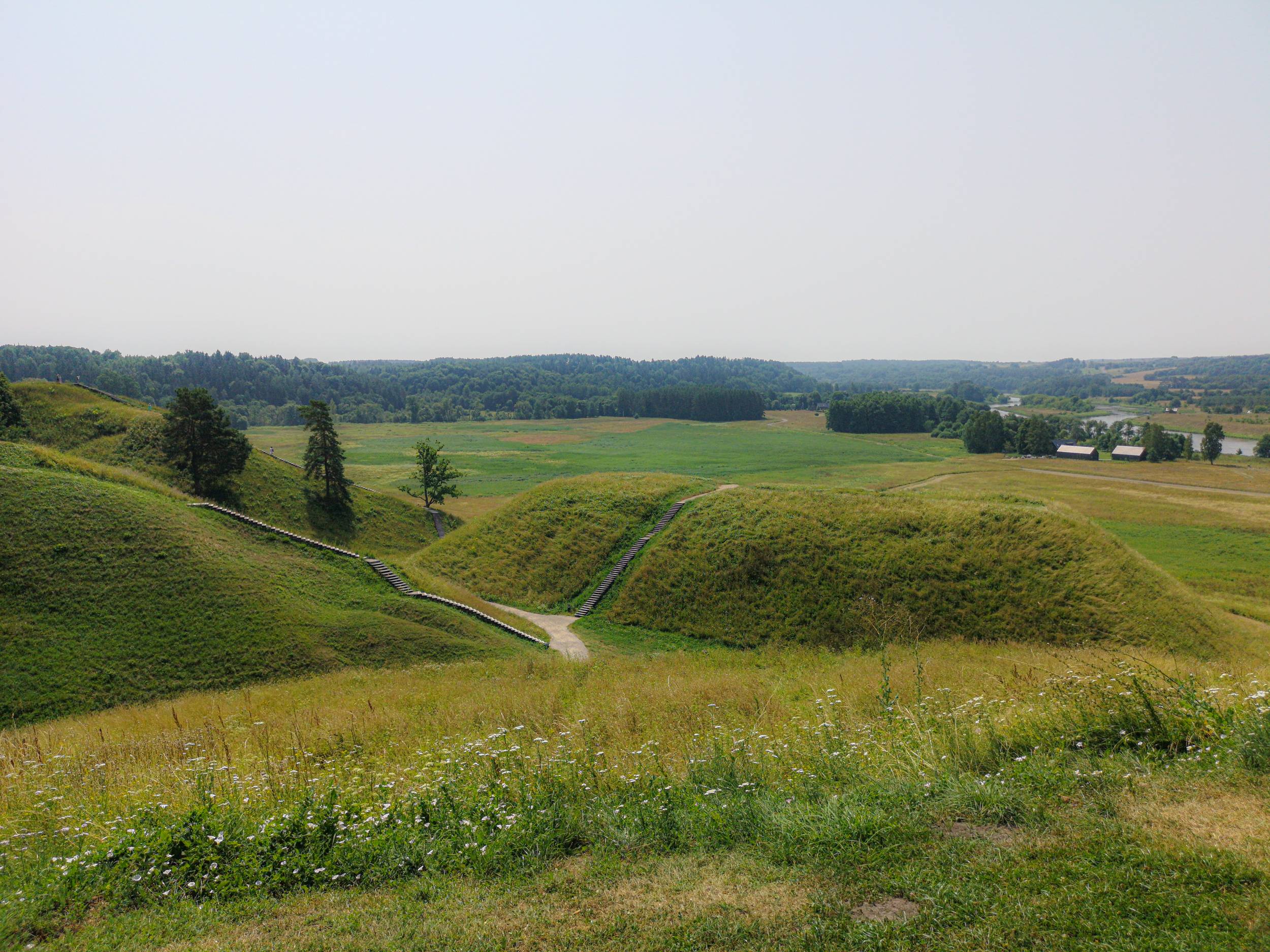
Though one of the mounds in Kernavė is called Mindaugas Throne Hillfort (left), there is no scientific evidence that Kernavė was his Capital. Photo by Alis Monte [CC BY-SA 4.0], via Connecting the Dots
The pagan archeological site is now surrounded by Catholic Churches, the ancient settlement have been moved from its original location, and Kernavė mounds are no longer housing the castles, but the landmark itself withstood the challenges thrown to it by the difficult history. Looking at it, I feel proud shivers in my veins, the landscape alone is enough to speak of Lithuania‘s great pagan past.
A visit to Kernavė Mounds Archeological Site is a great standalone day trip from Vilnius, or it could be combined with another historical Captical of Grand Duchy of Lithuania – Trakai. This is a must-visit place in the Republic of Lithuania for any history and culture fan.
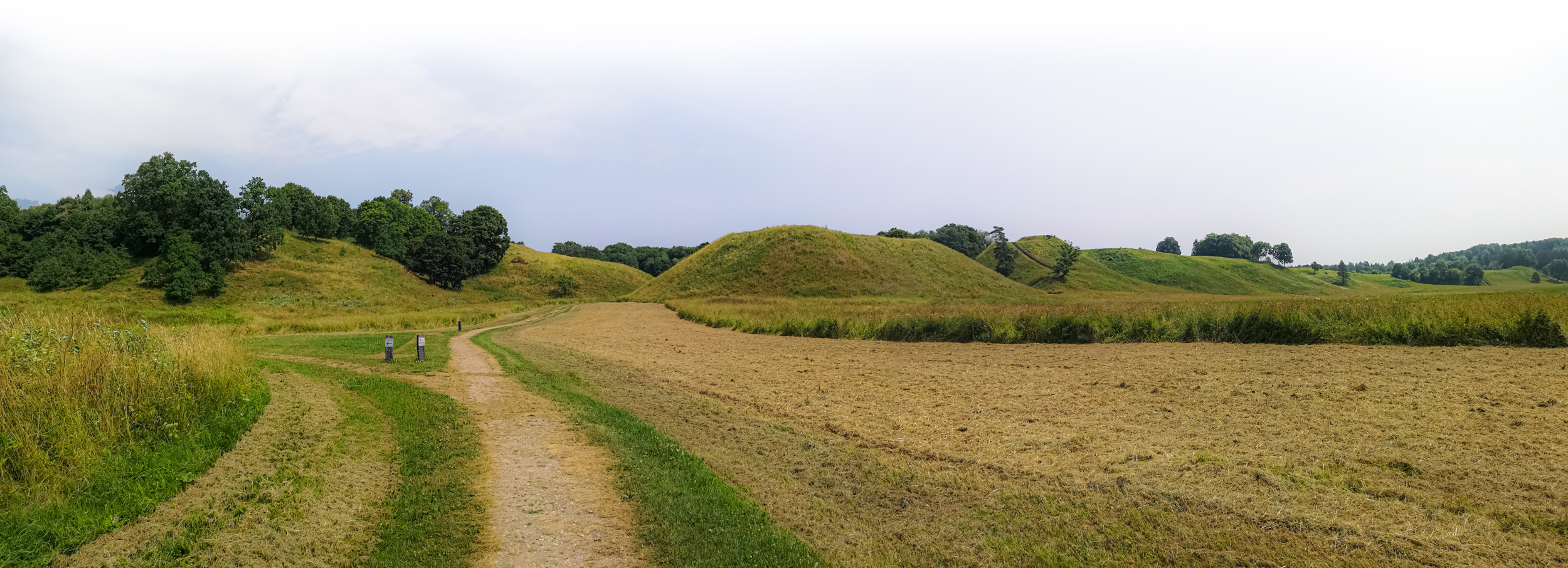
All content and photos by Alis Monte. If you want to collaborate, contact me on info@ctdots.eu Photo by Alis Monte [CC BY-SA 4.0], via Connecting the Dots